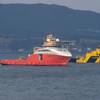While the impact of poor freight rates and low oil prices have been felt in all quarters of the Scandinavian maritime industries, the region's hull underwriters and P&I Clubs continue to benefit from the relatively strong domestic shipping and energy sectors. Scandinavian marine insurers have demonstrated resilience in challenging market conditions. The global hull market remains in a downswing of unusual severity. As for the P&I sector, the past 12 months have had a nervous character, with talk of mergers and the increasing profile of the fixed premium players.
The Swedish Club, the Gothenburg-headquartered marine mutual, is committed to both sectors - providing total package hull and P&I services. In the hull sector, the Club has refused to follow the market in its downward spiral. Director of underwriting & marketing Claes Lindh says: "Many players have poured vast sums into their attempts to defend market share. It would be unthinkable, however, for a marine mutual such as The Swedish Club to use members' funds to 'buy' new business by offering heavily discounted rates."
He adds: "Our primary aim in this difficult market is to defend the paramount principle of sound underwriting: premiums must cover claims."
The Swedish Club expects a major shakeout to develop in the global hull market, as conditions begin to harden. Many parties now locked into multi-year deals at cut-throat rates are bound to suffer. Few, if any, will escape heavy losses. At the mid-year point, Members' Agent Sedgwick Oakwood forecast breakeven for Lloyd's in 1997 and a loss of $198 million for 1998. In the marine sector, they predict a 2.51 percent loss, as against a 1.66 percent return for 1997.
In this stormy environment, The Swedish Club focuses on providing certainty. The hull portfolio now consists of 649 vessels, of around 20 million-gt, with the Club writing around 12 million-gt. Despite the market's freefall during the past two years, the Club's average order remains at around 52 percent. This reflects consistent performance within a framework founded on long-term relationships with members and reinsurers.
In the P&I sector, The Swedish Club portfolio continues to expand. In the year to the last renewals date (February 20), the P&I-entered fleet increased by 12 percent in terms of vessel numbers and by 25 percent in tonnage.
On this issue of merger, The Swedish Club made it clear two years ago that it had no interest in this option for future development. This policy was reaffirmed at the Club's annual meeting in Gothenburg in June of this year. The possibility of mergers elsewhere within the P&I community, however, are seen as growth opportunities - with the Club providing a fresh option for high quality owners of young tonnage looking for new alternatives.
With its focus on quality fleets, the Club has yet to lose a single vessel to the fixed premium P&I providers. Lindh adds: "We consider ourselves a fixed premium facility, in the sense that we have had no supplementary calls for the past eight years. In this way, we provide certainty."
Financial strength is a factor of crucial importance. The Swedish Club's free reserves now approach $90 million. This allowed the Club to discount the 1998/99 P&I premium by 10 percent, freeze the 1999/2000 P&I premium and close the 1998 hull year at 95 percent of premium for existing members.
During the past year, The Swedish Club has made significant progress in enhancing its loss prevention services for members. The Club's current loss prevention programme includes two major initiatives: continued support for Bridge Resource Management (BRM) training and a project aimed at reducing the incidence of main engine damage.
The Swedish Club, six other maritime organizations and the SAS Flight Academy signed a new BRM operating agreement earlier this year. This marked the sixth anniversary of the establishment of this global training program, which focuses on developing positive human behavior, which contributes to the safe and pollution-free operation of vessels.
The training is now known as SAS-BRM. So far, more than 6,000 seafarers have completed the programme, including more than 500 deck officers and engineers serving on vessels entered for hull and/or P&I cover with The Swedish Club.
As for main engine damage, the Club has taken measures to ensure that members are fully aware of the risks and problems associated with specific engine types, based on a careful analysis of engine damage cases. This has allowed the Club to offer the engine manufacturers a new dataset on engine performance in service. It is now engaged in discussions with the manufacturers, to encourage new initiatives designed to reduce main engine damage.
Subscribe for
Maritime Reporter E-News
Maritime Reporter E-News is the maritime industry's largest circulation and most authoritative ENews Service, delivered to your Email five times per week










